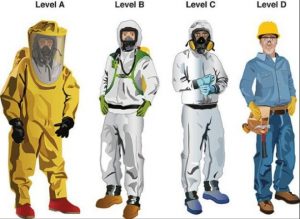TYPES OF PROTECTIVE CLOTHING
Having protective gear nearby is the first step before starting any job that may be potentially dangerous. Whether you’re dealing with fire, water or electricity, you are facing a number of risks to your well being. Arc flashes, for example, are unpredictable electrical explosions. The danger of arc flashes increases when a large enough explosion is caused to send high speed shrapnel turning it into an arc blast. Working in a lab can be just as dangerous at times when working with explosive and corrosive substances. Fortunately, the right kind of protective clothing can keep you safe, unscathed and intact. Read on to learn about the kind of clothing that fits you best.
FLAME RESISTANT AND ARC FLASH CLOTHING
There are a ton of complications that can occur while working with electricity that can cause fires. Although protective clothing against fire is the last line of defense, it does help to ensure that you’re not engulfed in flames. Arc flashes and blasts occur due to an electrical explosion because of ground to air electrical conduction or a separately occurring voltage phase. In either scenario, arc flashes can very easily be fatal given the unpredictable nature of these accidents. Arc flash clothing is available in everything from gloves to complete body overalls and should be worn every time you’re working on a high voltage conductor. The fabric used to make this gear consists of a premium nylon and cotton mix. The difference between arc flash clothing and fire resistant clothing is that although arc flash clothing is fire resistant, not all fire resistant clothing is arc flash rated. Fire resistant clothing is made of Nomex, Kevlar and Modacrylic fabrics. Check their website to find some great deals on arc flash clothing.

CHEMICAL RESISTANT CLOTHING
Being unsafe in a lab can result in skin issues, damages to your eyes, severe burns, deformation and a long list of unpleasant injuries that can easily be avoided by using the proper lab equipment. Plastic goggles can protect your eyes from harmful fumes for example just as rubber goggles can protect your skin from acid burns. Just as other kinds of protective clothing, chemical resistant clothing is rated as well. For industrial operations such as the case with pharmaceuticals, overalls are available which protect lab workers from head to toe. Some suits even contain ventilation systems that offer protection when a chemical process produces clouds of corrosive vapour.
CONSTRUCTION EQUIPMENT
Construction sites are home to some of the brutal accidents given the heavy operations that are constantly going on and the heights sometimes involved. A single bolt or piece of metal that falls from a high enough place can be fatal to anyone who is unfortunate enough to be standing under it. Everyone is required by law to wear a helmet while visiting a construction site because of this very reason. Protective equipment for construction consists of hard hats, plastic goggles, thick gloves, ear muffs and boots. Workplace accidents are very common but being protected against them is the first priority. Carrying equipment, welding, working at high places and practically every step of the construction process is dangerous.
WATER PROTECTIVE CLOTHING
Water can be just as harmful as fire, chemicals or falling construction materials from the sky. Cleaning out septic tanks, working in the sewers or dealing with a flooded neighbourhood for instance can lead to a myriad of skin issues and infections from water borne diseases. In industrial environments, water jets from pipes can be very dangerous. These pipes sometimes contain water vapour that is contained at high pressure at temperatures of up to 300-400 Degrees Celsius. Simple protective gear for water purposes includes rain suits made of plastic that water is impermeable to. However, advanced protective gear consists of a full body suit made of silicone para aramid layers and viscone fire resistant fabric. It is able to protect you from high pressure streams of water as well as scalding vapours. These full body suits also come equipped with ventilation as well!
Every step should be taken to ensure that no accidents occur and you never have to use your protective clothing. But being safe on the job is the first priority that should come to your mind before beginning a project. Whether it be fire, chemicals, water or construction, protective gear exists that can potentially save lives. The different types of protective clothing mentioned in this article is specifically engineered for the purpose it fulfills by blending a combination of the most advanced materials available to us. Protective clothing are using the latest technology to design equipment that you can depend on so you can work without the deeply uncomfortable threat of getting injured.